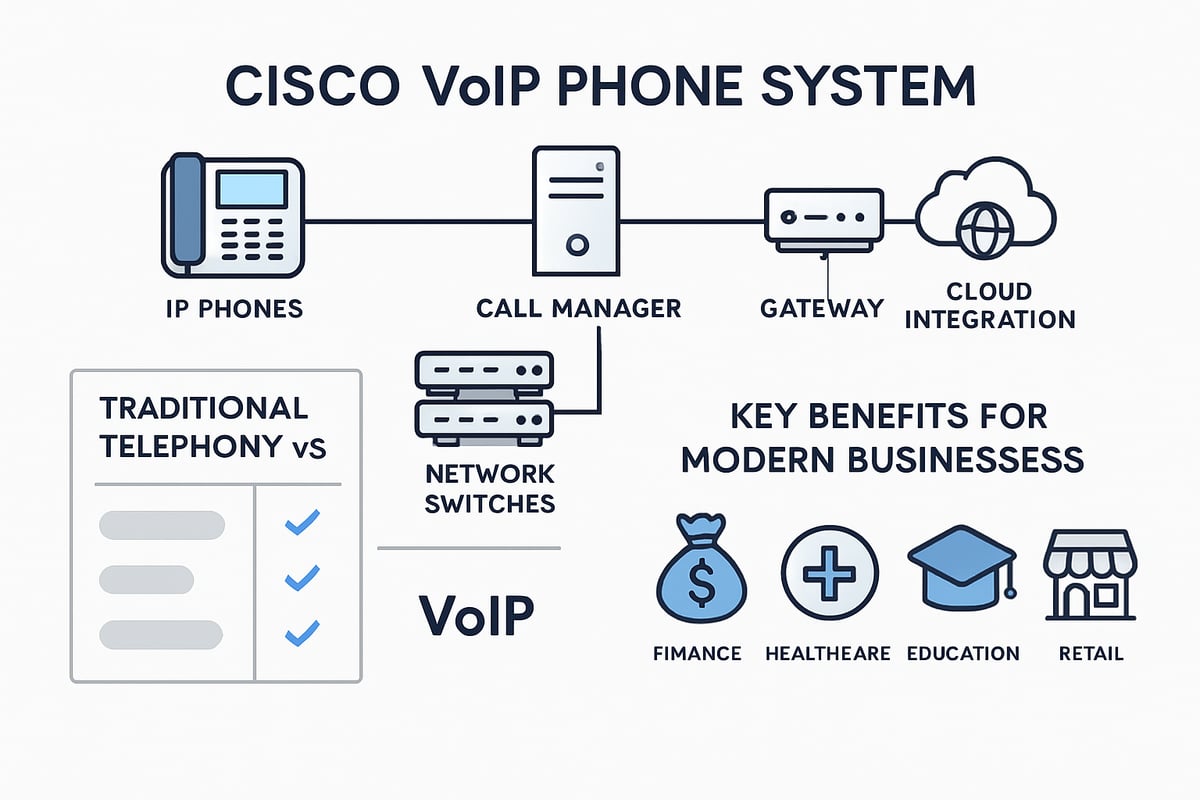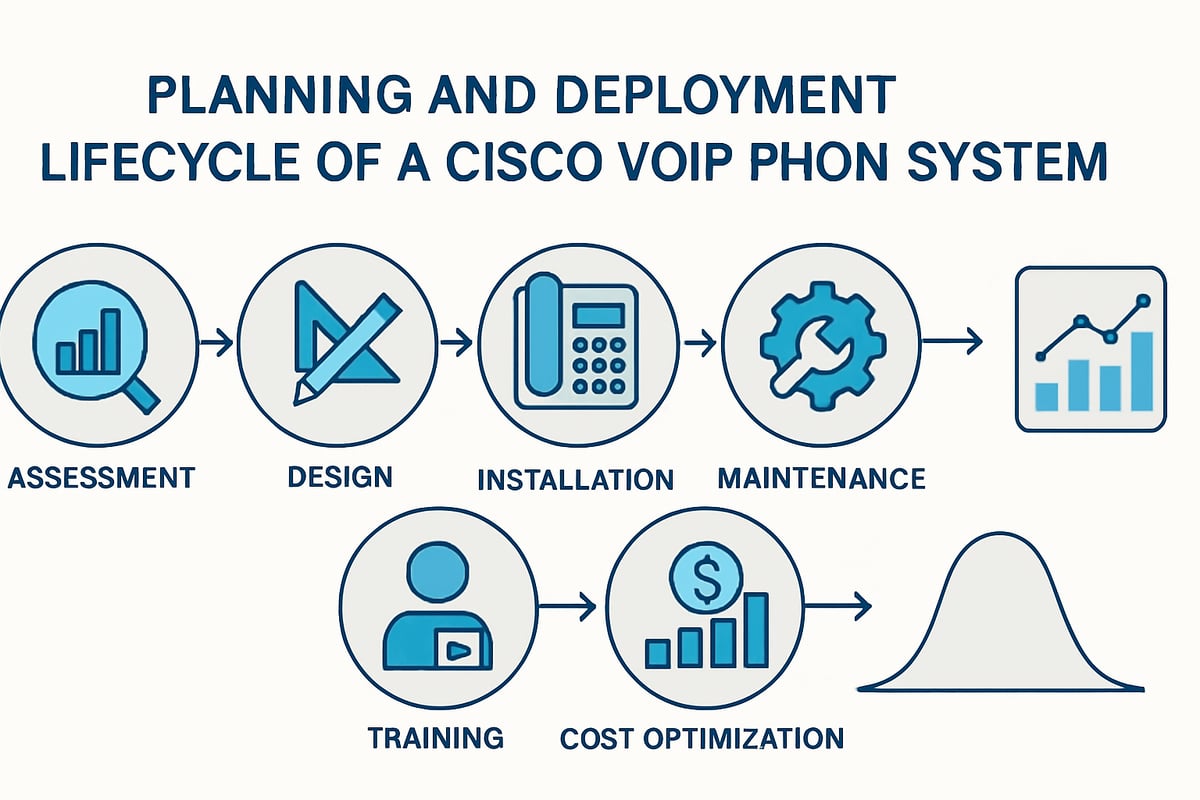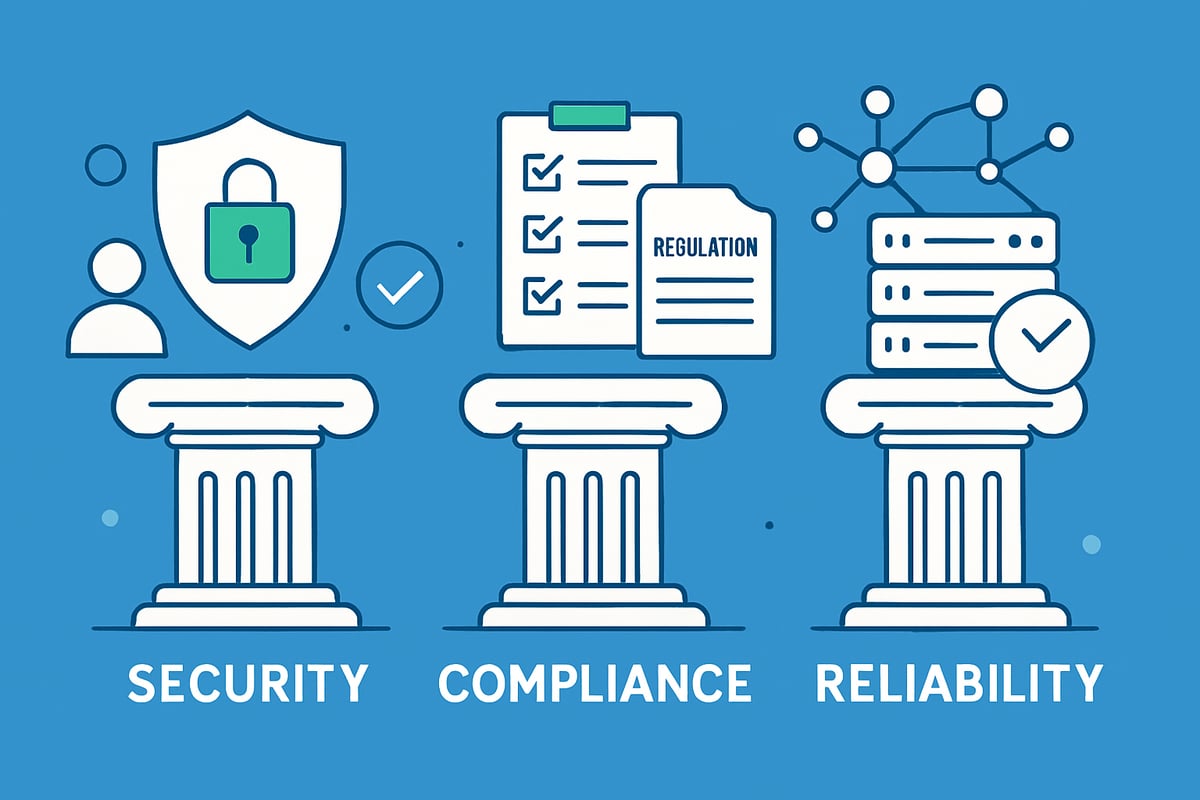Cisco VoIP Phone System Guide: Essential Insights for 2025
Discover essential insights on the Cisco VoIP phone system for 2025. Learn features, deployment, security, and integration tips to future proof your business communications.
Redaction
04/10/2025, 12:30:00As businesses prepare for the demands of 2025, the need for reliable, scalable communication solutions has never been greater. A cisco voip phone system stands out as a modern answer for organizations seeking to enhance connectivity and future-proof their operations.
This guide breaks down what you need to know - covering system fundamentals, the latest features, smart deployment strategies, security best practices, integration options, and emerging trends.
Discover how adopting advanced VoIP can transform your business efficiency, learn why Cisco leads the way, and gain actionable insights to make informed decisions for the year ahead.
Understanding Cisco VoIP Phone Systems
As businesses strive for greater agility and efficiency, understanding what sets a cisco voip phone system apart is essential. This section unpacks the core concepts, components, benefits, and widespread adoption behind Cisco’s technology, providing a clear foundation for your 2025 communications strategy.

What is VoIP and How Does Cisco Lead?
VoIP, or Voice over Internet Protocol, revolutionizes business communication by transmitting voice calls over data networks instead of traditional phone lines. This evolution has enabled organizations to move beyond the limitations of analog systems, offering flexibility and advanced features.
Cisco’s leadership in this field is rooted in decades of innovation and reliability. Unlike legacy telephony, a cisco voip phone system uses digital signals, which drastically reduces costs and improves scalability. Key differences include the ability to integrate with various business applications, advanced call routing, and simplified infrastructure management.
| Traditional Telephony | Cisco VoIP Phone System |
|---|---|
| Analog lines | Digital/IP based |
| Limited features | Rich features |
| Costly scaling | Flexible & scalable |
| On-premises only | Cloud/hybrid ready |
Cisco’s reputation is built on delivering secure, high-performance solutions that adapt to evolving business needs.
Core Components of a Cisco VoIP System
A typical cisco voip phone system is composed of several integrated hardware and software elements. At its heart are Cisco IP phones, which connect to the network via Ethernet and receive power through PoE, eliminating the need for separate power supplies.
The Cisco Unified Communications Manager (CUCM) serves as the call control platform, managing call routing, features, and user profiles. Network switches and routers play a pivotal role in ensuring reliable connectivity and prioritizing voice traffic.
Gateways bridge VoIP to external networks or traditional phone lines. For a deeper dive into the PBX aspect, see this VoIP PBX solutions overview, which is integral to many Cisco deployments.
A standard setup may include:
- Cisco 8800 Series IP phones
- CUCM software
- Cisco Catalyst switches (PoE-enabled)
- Voice gateways for PSTN integration
This stack delivers a robust, secure, and highly customizable communication environment.
Key Benefits for Modern Businesses
Adopting a cisco voip phone system offers tangible advantages for today’s organizations. One of the most significant benefits is cost savings, as VoIP reduces the need for dedicated phone lines and lowers long-distance charges.
Operational efficiency improves with features like voicemail-to-email, call forwarding, and advanced conferencing. Remote work becomes seamless, as employees can connect from anywhere with internet access. Integration with platforms like Webex and Microsoft Teams enables unified collaboration across devices and locations.
Small and midsize businesses (SMBs), for example, have leveraged Cisco VoIP to scale operations quickly without heavy infrastructure investments. This flexibility supports growth and keeps communication agile in a fast-changing market.
Common Use Cases and Industry Adoption
A cisco voip phone system is widely adopted across industries such as finance, healthcare, education, and retail. Financial institutions benefit from secure, compliant communications, while healthcare providers streamline patient coordination.
Multi-site organizations unify their communication channels, simplifying management and enhancing customer service. Hybrid and remote work models thrive due to the system’s mobility and scalability.
Recent statistics highlight VoIP’s rapid adoption, with Cisco maintaining a significant market share among both enterprises and SMBs. In large organizations, Cisco VoIP supports thousands of users with advanced features, while small businesses appreciate its cost-effectiveness and ease of use.
Cisco VoIP Phone System Features & Innovations for 2025
Staying ahead in business communications requires investing in a cisco voip phone system that evolves with technology. As we approach 2025, Cisco continues to lead by introducing advanced features and innovations that address modern workplace demands.

Latest Hardware and Software Advancements
Cisco has refreshed its cisco voip phone system lineup for 2025, unveiling new IP phones with enhanced HD audio and video capabilities. The latest models feature intuitive touchscreen interfaces and integrate smoothly with smart devices.
Firmware updates now offer improved security protocols and faster processing, ensuring reliable performance. The Cisco 8800 Series, for example, receives better video conferencing and energy-saving options. Power over Ethernet support simplifies installation across workspaces. These comprehensive upgrades make the cisco voip phone system a future-proof investment for organizations of all sizes.
Unified Communications and Collaboration
A modern cisco voip phone system is more than just voice calls. Cisco’s deep integration with Webex enables seamless meetings, instant messaging, and team collaboration from any device. Presence indicators and real-time analytics empower teams to connect and work efficiently, whether in the office or remotely.
Mobile app extensions let employees join calls or conferences from anywhere. Reporting tools give managers actionable insights into communication patterns. For businesses seeking a unified workflow, the cisco voip phone system delivers a robust collaboration platform that scales with changing needs.
Security Enhancements and Compliance
Security remains a top priority in every cisco voip phone system. Cisco implements end-to-end encryption for all voice and data transmissions, protecting sensitive information from threats. Role-based access and secure provisioning limit exposure to potential breaches.
Compliance with regulations such as GDPR and HIPAA is built into system design, with multi-factor authentication and secure remote access for distributed teams. Financial and healthcare sectors benefit from these controls, ensuring the cisco voip phone system meets strict industry requirements. Regular updates keep defenses strong against emerging risks.
AI and Automation in Cisco VoIP
Artificial intelligence is transforming the cisco voip phone system landscape. AI-powered call routing ensures customers reach the right agent quickly, while virtual assistants automate routine tasks. Automated transcription and sentiment analysis improve call quality and customer experience.
Predictive maintenance helps IT teams address issues before they escalate, and AI-driven fraud detection reduces spam and malicious calls. To explore these advancements further, see Cisco's AI-Powered VoIP Innovations. In 2025, AI will continue to drive efficiency and reliability in Cisco VoIP environments.
Scalability and Cloud-Readiness
A key strength of the cisco voip phone system is its flexibility in deployment. Organizations can choose between on-premises, cloud, or hybrid models, adapting to their growth and security needs. Cisco Webex Calling supports rapid scaling, making it ideal for businesses expanding regionally or globally.
Flexible licensing and subscription options allow for cost-effective scaling. Whether it is a small startup or a large enterprise, the cisco voip phone system is designed for seamless upgrades and future expansion. This ensures communication infrastructure remains agile and ready for tomorrow’s challenges.
Planning and Deploying a Cisco VoIP Phone System
Upgrading to a cisco voip phone system requires careful planning and a methodical approach. Each phase of deployment impacts long-term performance and user satisfaction. Let us break down the essential steps to ensure a smooth transition and optimal results.

Assessing Business Needs and Readiness
Begin by evaluating your current communication setup. Identify pain points, such as outdated hardware or limited remote work capabilities. Involve stakeholders from IT, finance, and operations to gather requirements for your cisco voip phone system.
Conduct a network assessment, focusing on bandwidth, latency, and Quality of Service. Determine if your infrastructure supports VoIP traffic. Set a realistic budget and estimate ROI, considering both initial investment and long-term savings.
For instance, an SMB may prioritize flexibility and cost, while an enterprise might need advanced features and higher capacity. This initial step ensures your cisco voip phone system deployment aligns with business goals.
Step-by-Step Deployment Process
A structured approach is crucial for deploying a cisco voip phone system. Start with detailed planning, including network topology, hardware selection, and software licensing. Design your system to support current and future needs.
Prepare the network by configuring VLANs, enabling PoE, and implementing security measures. Install hardware such as Cisco IP phones, switches, and routers. Configure the Unified Communications Manager and connect gateways.
Run comprehensive tests to validate call quality, redundancy, and failover. After a successful pilot, move to full deployment. Review the process post-launch to address any issues and optimize for your environment.
Best Practices for Network Configuration
Optimizing your network is essential when implementing a cisco voip phone system. Segment voice traffic onto dedicated VLANs to isolate it from data traffic and improve reliability. Set Quality of Service parameters to prioritize voice packets and minimize latency.
Plan for redundancy by deploying backup links and failover protocols. Use robust monitoring tools to track performance and detect anomalies. Regularly review configurations to adapt to business growth or changes in network usage.
For example, a typical setup uses separate VLANs for voice and data, with QoS policies applied to ensure clear, uninterrupted calls. These best practices support a stable and high-performing cisco voip phone system.
Managing User Adoption and Training
User adoption is a critical factor in the success of any cisco voip phone system rollout. Develop comprehensive onboarding and training programs tailored to different user groups. Provide clear, step-by-step documentation and accessible support resources.
Implement change management strategies to address resistance and encourage engagement. Establish feedback loops, such as surveys or helpdesk channels, to identify areas for ongoing improvement.
A distributed workforce can benefit from virtual training sessions and quick reference guides. By focusing on user needs, your cisco voip phone system achieves higher satisfaction and productivity.
Ongoing Maintenance and Support
Maintaining a cisco voip phone system involves regular updates, proactive monitoring, and responsive support. Schedule firmware and software updates to keep devices secure and current. Use analytics to monitor call quality and network health.
Troubleshoot issues promptly, leveraging Cisco's Technical Assistance Center and online community forums for expert guidance. Conduct periodic system audits to identify vulnerabilities or inefficiencies.
Establish a maintenance calendar to ensure all components of your cisco voip phone system operate reliably. Regular reviews enable continuous improvement and long-term stability.
Cost Management and Optimization
Effective budgeting is key to maximizing the value of your cisco voip phone system. Understand the different licensing and subscription models available. Monitor usage patterns to uncover cost-saving opportunities, such as optimizing SIP trunking or scaling licenses based on demand.
Leverage analytics to allocate resources efficiently and plan for future upgrades. For detailed insights into pricing options and strategies, consult the VoIP phone pricing guide.
Plan for future growth by setting aside budget for system enhancements and scalability. Proactive cost management ensures your cisco voip phone system remains a strategic asset.
Security, Compliance, and Reliability in Cisco VoIP
Modern organizations rely on the cisco voip phone system as the backbone of their communications. With increased adoption comes heightened attention to security, regulatory compliance, and reliability. These pillars are essential for protecting sensitive data, maintaining business continuity, and building trust across distributed teams.

Identifying and Mitigating VoIP Security Risks
Securing a cisco voip phone system starts by understanding the most common threats. These include eavesdropping, call spoofing, and distributed denial-of-service attacks targeting VoIP networks. Attackers seek to intercept voice data or disrupt business operations.
To address these risks, Cisco embeds strong security features such as encrypted signaling and media streams, secure provisioning, and role-based access controls. Network segmentation is critical, separating voice traffic from data to limit exposure. Regular security audits and vulnerability assessments help detect and remedy weaknesses before they are exploited.
Incident response planning is essential. By preparing for potential breaches, organizations can minimize downtime and data loss. Investing in the right tools and best practices ensures the cisco voip phone system remains secure against evolving threats.
Ensuring Regulatory Compliance
Compliance is a top priority for any cisco voip phone system, especially in regulated industries like healthcare and finance. Key regulations such as GDPR, HIPAA, and PCI DSS mandate strict controls over data privacy, retention, and lawful interception.
Cisco equips its VoIP solutions with comprehensive compliance tools and documentation. Features like encrypted call storage, detailed audit logs, and secure lawful interception support help organizations meet regulatory standards. Data retention policies can be tailored to fit industry-specific requirements.
For example, healthcare providers can follow a compliance checklist to ensure their cisco voip phone system aligns with HIPAA guidelines. Staying compliant not only avoids penalties but also safeguards the reputation and trust of your organization.
Reliability and High Availability Strategies
Reliability is a cornerstone of the cisco voip phone system, as downtime can disrupt critical communications. Achieving high availability involves deploying redundant hardware, failover mechanisms, and robust disaster recovery plans.
Service Level Agreements (SLAs) and uptime guarantees are standard in Cisco deployments. Monitoring and alerting systems provide early warnings of potential issues, allowing IT teams to act before users are affected. Hosted voice solutions, as explained in Hosted voice solutions explained, offer additional resilience by leveraging cloud infrastructure for failover and scalability.
A well-designed cisco voip phone system ensures business continuity, even in the face of hardware failures or network outages. Planning for reliability is not optional, it is critical for modern enterprises.
Secure Remote and Hybrid Work Enablement
The cisco voip phone system empowers organizations to support remote and hybrid workforces securely. VPNs and secure remote extensions connect staff to corporate resources while maintaining privacy and integrity of voice data.
Mobile device management and BYOD policies further enhance security for users working outside the corporate firewall. Cisco provides tools for secure collaboration, including encrypted communications and role-based controls for remote access.
For global teams, the cisco voip phone system enables consistent, secure communication regardless of location. Supporting a distributed workforce requires diligent planning, but the rewards are greater flexibility and productivity.
Performance Monitoring and Incident Response
Ongoing performance monitoring is vital for a cisco voip phone system. Real-time analytics track call quality, network health, and system performance. Automated alerts notify IT staff of anomalies, enabling rapid incident response.
Root cause analysis helps quickly resolve issues and prevent recurrence. Cisco’s analytics and reporting tools provide actionable insights for continuous improvement. Regular reviews ensure the cisco voip phone system remains reliable and resilient as business needs evolve.
Combining proactive monitoring with an effective incident response plan keeps communications running smoothly and protects organizational reputation.
Integrating Cisco VoIP with Business Applications and Workflows
Seamlessly integrating the cisco voip phone system with core business applications is crucial for maximizing productivity and communication efficiency. As organizations modernize their workflows, the ability to connect voice, data, and collaboration tools defines the agility and competitive edge of the workplace.
CRM, ERP, and Productivity Tool Integration
Integrating the cisco voip phone system with platforms like Salesforce, Microsoft 365, and leading ERP tools empowers teams to work smarter. When calls are automatically logged in CRM, customer histories update in real time, giving support and sales staff a 360-degree view of interactions.
Key integration benefits include:
- Automated call logging and activity tracking in CRM
- Click-to-call from within business apps
- Screen pop with caller details for improved response
- Unified reporting of call and customer data
For example, a sales team using cisco voip phone system with Salesforce can initiate calls directly from contact records. Productivity rises as manual entry drops, and managers gain insight into customer engagement patterns.
APIs and Customization Options
The cisco voip phone system offers robust APIs, enabling businesses to tailor communication flows to their exact needs. With these APIs, developers can build custom automations, integrate third-party apps, or even create entirely new workflows.
Common API use cases include:
- Designing custom call routing based on business rules
- Integrating with helpdesk or ticketing systems
- Automating notifications and escalations
- Embedding VoIP features into proprietary apps
Developer resources and support from Cisco streamline the process. For example, a call center can use APIs to route high-priority calls to specialized agents, ensuring that critical issues are addressed promptly within the cisco voip phone system environment.
Enhancing Collaboration with Unified Messaging
Unified messaging brings together voicemail, SMS, instant messaging, and video into a single dashboard within the cisco voip phone system. Integration with platforms like Cisco Webex and Microsoft Teams centralizes communication, making it easy for distributed teams to stay connected.
Key features include:
- Voicemail-to-email and real-time alerts
- Integrated chat and video meetings
- Centralized message management across devices
Recent Webex Calling Enhancements 2025 have expanded these capabilities with smarter notifications and deeper collaboration options. As a result, organizations can boost productivity and responsiveness by unifying their communications stack around the cisco voip phone system.
Future Integration Trends for 2025
Looking ahead, the cisco voip phone system is poised to leverage emerging technologies for even deeper integration. AI-driven automation, omnichannel communication, and predictive analytics are reshaping how businesses connect voice with other workflows.
Trends to watch:
- AI-powered call routing and agent assistance
- Omnichannel engagement across voice, chat, and video
- Cloud-native apps and API-first development strategies
- Predictive analytics for customer insights
Cisco’s Agentic Collaboration Capabilities are set to revolutionize how teams interact, automate, and collaborate by 2025. Organizations adopting these next-gen integrations within their cisco voip phone system will be better prepared for evolving business needs.
Cisco VoIP Trends and Future Outlook for 2025
As we look ahead to 2025, the cisco voip phone system is poised for significant transformation. Businesses of all sizes are preparing to leverage new technologies and features to drive communication efficiency. Staying informed about market trends, technological advancements, and evolving user expectations will be critical for organizations aiming to maintain a competitive edge.
Market Growth and Adoption Projections
The global VoIP market is expected to surpass $100 billion by 2025, with the cisco voip phone system maintaining a strong presence among both SMBs and enterprises. Cisco’s market share remains robust, particularly in sectors where reliability and scalability are paramount. Adoption trends show rapid growth in emerging markets, with organizations seeking cost-effective, flexible communication solutions.
According to recent analyst forecasts, SMBs are accelerating their move to IP-based telephony, while large enterprises are investing in unified communications platforms. For a broader view of industry leaders, see this Best VoIP service providers comparison. These trends highlight the continued relevance of Cisco’s solutions as businesses modernize their infrastructure.
Emerging Technologies Impacting Cisco VoIP
Several emerging technologies are reshaping the cisco voip phone system landscape. The integration of 5G and Wi-Fi 6 is enabling higher call quality and more reliable mobile connections. AI and machine learning are powering intelligent call routing, predictive analytics, and enhanced security features. The Internet of Things (IoT) is also influencing VoIP, allowing for smarter office environments and automated device management.
Blockchain technology is beginning to play a role in secure voice communications, especially in industries with strict data integrity requirements. Smart office deployments now include voice-enabled controls, connected sensors, and seamless interoperability between devices, all supported by Cisco’s evolving platform.
Evolving User Expectations and Experience
User expectations for the cisco voip phone system are shifting rapidly. Today’s employees demand seamless, mobile-first experiences that support both in-office and remote work. Personalization is on the rise, with AI-powered assistants helping to manage calls, schedule meetings, and transcribe conversations for improved productivity.
Accessibility and inclusivity are also front of mind, with features like real-time transcription, voice commands, and interface customization becoming standard. Voice-enabled productivity tools are setting new benchmarks for user experience, ensuring that communication remains intuitive and efficient for everyone. For small businesses, Cisco’s tailored solutions address these evolving needs directly.
Preparing Your Organization for the Future
To fully benefit from the advancements in cisco voip phone system technology, organizations should proactively assess their readiness. This includes evaluating current infrastructure, training IT teams on new features, and budgeting for upgrades to support innovation. Building an agile communication strategy ensures your business can quickly adapt to new trends and customer expectations.
A well-structured roadmap for VoIP adoption in 2025 might include pilot programs, phased rollouts, and continuous feedback loops. By prioritizing flexibility and scalability, companies can future-proof their communication systems and stay ahead of industry shifts.
Resources for Staying Updated on Cisco VoIP
Keeping up with the latest in cisco voip phone system advancements requires ongoing learning. Cisco’s official blogs, webinars, and technical documentation are invaluable resources. Industry conferences, online forums, and certification programs also offer opportunities for professional growth and networking.
For small businesses seeking a starting point, explore Cisco's Small Business VoIP Solutions for tailored guidance and product updates. Continuous education ensures IT professionals remain equipped to handle future changes and maximize the potential of VoIP technology.As we look ahead to 2025, staying ahead in business communication means choosing tools that are reliable, scalable, and ready for tomorrow’s challenges. You’ve just explored how Cisco VoIP phone systems can transform your organization with advanced features, real-time analytics, and seamless integration for global teams. If you’re ready to put these insights into action and experience enterprise grade communication solutions, now’s the perfect moment to take the next step. Let’s make your business communications future proof - Start now!